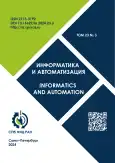Vol 23, No 3 (2024)
Information security
A Private Semi-Markov Model as a Tool to Reduce the Complexity of the Task of Assessing the Stability of the Functioning of Elements of the Information Infrastructure Exposed to Threats
Abstract
 611-641
611-641


Methodology for Collecting Data on the Activity of Malware for Windows OS Based on MITRE ATT&CK
Abstract
 642-683
642-683


A Method to Quantitative Compare Obfuscating Ttransformations
Abstract
 684-726
684-726


Digital information telecommunication technologies
Decentralized Protocol for Organizing Sustainable Interaction between Subscribers in Networks with High Dynamics of Topology Changes
Abstract
 727-765
727-765


Recovery of Discrete-Time Signal Based on the Moving Average Model and Estimation of the Samples Correlation in Forward and Reverse Forecasting
Abstract
 766-800
766-800


A Genetic Approach-Based Intra Coding Algorithm for H.266/VVC
Abstract
This paper presents a genetic approach for optimizing intra coding in H.266/VVC. The proposed algorithm efficiently selects coding tools and Multi-Type Tree (MTT) partitions to achieve a balance between encoding time and video quality. The fitness evaluation function, which combines perceptual metrics and coding efficiency metrics, is used to assess the quality of each candidate solution. The results demonstrate a significant reduction in encoding time without compromising video quality. The proposed algorithm selects coding tools from a set of available tools in H.266/VVC. These tools include intra prediction modes, transform units, quantization parameters, and entropy coding modes. The MTT partitioning scheme includes four types of partitions: quadtree, binary tree, ternary tree, and quad-binary tree. Perceptual metrics are used to evaluate the visual quality of the encoded video. Coding efficiency metrics are used to evaluate the coding efficiency of the encoded video. The fitness evaluation function combines perceptual metrics and coding efficiency metrics to assess the quality of each candidate solution.
 801-830
801-830


Models of Composite Harmonic Half-Waves and the Relationship of Time Sampling with the Entropy of Time Parameters of Signals
Abstract
 831-858
831-858


Hardware Compression Method for On-Chip and Interprocessor Networks with Wide Channels and Wormhole Flow Control Policy
Abstract
 859-885
859-885


Robotics, automation and control systems
Classification of Spatial Temporal Patterns Based on Neuromorphic Networks
Abstract
 886-908
886-908


Development of a Stress-Free Algorithm for Control of Running Platforms Based on Neural Network Technologies
Abstract
 909-935
909-935











